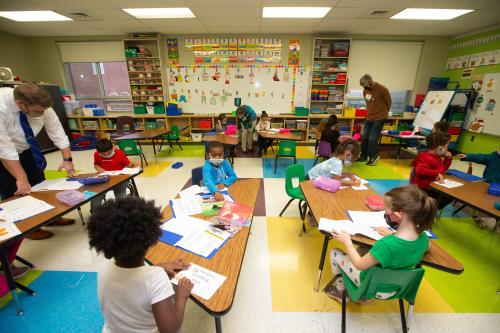This post was produced in collaboration with the academic journal Educational Evaluation and Policy Analysis.
The recruitment, retention, and development of talented educators is a critical part of efforts to improve student outcomes. Over the past decade, policymakers in more than 45 states and the District of Columbia have invested in the design and implementation of next-generation teacher evaluation systems, which included tenure reforms, widespread use of standards-based teacher performance rubrics, and more frequent and structured observation processes.
A key component of these next-generation teacher evaluation systems is post-observation performance feedback. Unlike other aspects of the evaluation systems, feedback takes an explicitly developmental approach to achieve better outcomes: Teachers develop as professionals and improve their skills in response to direct feedback on their practice. Though this is what is supposed to happen in theory, there is almost no research investigating the type of feedback that teachers receive and whether this feedback is targeted toward certain teachers or associated with improved outcomes. Given that most states require at least one formal classroom observation each school year, with early-career teachers often receiving more, our limited understanding of the quality and value of feedback to improve teacher performance is a major weakness in newly revised evaluation systems.
Our new study, published in Educational Evaluation and Policy Analysis, tried to shed light on these issues by using a novel strategy to investigate the relationship between teacher feedback and future teacher performance in Tennessee. Our findings suggest that while less-effective early-career teachers receive higher dosages of feedback with research-based, performance-enhancing qualities, feedback processes within Tennessee’s teacher evaluation system are not, on the whole, working as policymakers intended.
The study
To better understand the type of feedback provided in teacher-evaluation systems, we conducted a radically different study from prior work in this area. First, we identified specific feedback characteristics that educational, psychological, and management research has linked to performance improvement. This step yielded four characteristics associated with employee performance improvement: whether feedback a) is aligned with an improvement area, b) discusses the feedback’s evidential basis, c) sets specific improvement goals, and d) includes actionable next steps. We call these four qualities critical feedback characteristics (CFCs).
Table 1: Critical feedback characteristics
| Characteristic | Definition | Examples from written feedback to teachers |
| Alignment | Feedback references language from weakest indicator. | “Oral feedback during the lesson was academically focused. For future lessons, students will engage in effective feedback to each other.” |
| Evidence | Feedback mentions behavior of teacher/students, although description may be vague. | “The teacher’s questions were varied and high quality, mostly relied on volunteers.” |
| Goal-Setting | Feedback directly tells teacher to change behavior or instruction. | “By the end of the third nine weeks, the teacher will include clear measurement criteria for all assessments.” |
| Actionable | Feedback suggests a mechanism by which teacher can change behavior or instruction. | “Continue to use strategies to increase student interaction and curiosity like, “What can we add to the answer to help it be even more accurate?” Allow nine or so seconds of wait time before offering help or hints. This should greatly increase participation and unsolicited responses.” |
Next, we applied our CFC framework to the feedback provided to teachers. To do so, we accessed the written feedback that trained observers provided to approximately 1,200 early-career Tennessee teachers throughout an academic year during formal post-observation conferences. We reviewed nearly 5,000 written feedback episodes for these teachers, most of whom received four episodes annually, carefully transforming this text data into quantitative measures of CFCs.
As a final step, we calculated the share of each teacher’s conferences that included each CFC, resulting in four scores for each early-career teacher. Doing so allowed us to examine the relationship between each CFC and teacher characteristics, including years of teaching experience, highest degree held, and measures of teacher performance.
Absence of CFCs in written observer feedback
Despite the developmental aims of teacher performance feedback systems, we found that few early-career teachers’ conferences included CFCs. Over an academic year, nearly half of the teachers in our sample did not receive any actionable or goal-setting feedback across all of their feedback episodes, and nearly one-third did not receive feedback referencing evidence.
In most teachers’ conferences, the only CFC present was feedback aligned to an identified improvement area. Given that the Tennessee information-management system used to record observer feedback forces the observer to identify an area of strength and improvement after every observation, this represents the lowest level of feedback a teacher could receive. That is, it may be more indicative of a generic response rather than of a set of individualized comments to support a teacher’s development. Yet, even then, only 66% of the typical early-career teacher’s conferences included critical feedback aligning with the teacher’s area of refinement.
We also found that evaluators provided unidimensional feedback. Teachers receiving high dosages of one CFC (e.g., feedback referencing evidence) tend to not receive high dosages of the other CFCs. This pattern may imply that evaluators view CFCs as interchangeable or that they are not well-equipped to provide multiple CFCs per observation episode. This is unfortunate since our review of the literature implies that the receipt of multiple CFCs would benefit teachers.
Observers issue CFCs to teachers that need it most
Despite the low concentration of CFCs received by teachers, our data show observers may issue CFCs to the early-career teachers who need it most. Evaluators were more likely to provide higher concentrations of CFCs to those early-career teachers who were the least effective in terms of Tennessee’s de facto teacher-effectiveness measure. This is a potentially important insight in that it suggests that, while the feedback received may not be as high-quality or multi-faceted as intended, the provision of the feedback provided was strategically allocated to those most in need of improvement. It is promising that lower-performing teachers receive conferences with theoretically performance-enhancing feedback.
CFCs and better teacher performance
On average, the receipt of higher shares of critical feedback across conferences was not associated with subsequent teacher performance. However, the receipt of goal-setting feedback was associated with better value-added scores for teachers with less than a master’s degree and the fewest years on the job. Goal-setting feedback may be important for these teachers as they may not have had enough exposure to teacher-performance expectations at the earliest stage of their careers.
Conclusions and implications
Our results affirm both the potential promise but also the current limitations of post-observation performance feedback systems. Despite the developmental aims of these systems, our results indicate that few teachers received the kind of tailored, substantive feedback necessary to improve their practice. Indeed, a sizeable portion did not receive any feedback aligned with research-based best practices; those who did tended to receive it on a single dimension despite the considerable complexity of teaching practice. More discouraging, the feedback showed little association with improved student outcomes.
We recognize that our findings conflict with some prior research. For example, teacher survey results suggest that teachers receive CFCs. Our findings may differ because we focused on written feedback only, while teacher survey results may include written and verbal feedback. However, a recent national study reports that teacher evaluation reforms do not improve student achievement or non-academic outcomes on average, while some district and state studies have found more positive effects on student and teacher outcomes, including a Missouri study that finds positive effects on student achievement in disadvantaged rural schools.
Despite the disappointing results on the quality and effect of feedback currently received by teachers, there is still reason to be optimistic about the future potential of feedback systems. As with all education reforms, implementation is key and our findings suggest this case is no different. Our study suggests that, while trained observers are effective at allocating feedback to those teachers who need it most, the feedback itself is not yet as rich as it could be. Support providers might aim to develop multidimensional feedback, a likely higher-leverage strategy at improving teacher performance than the unidimensional feedback observed in our study. Targeted development of feedback skills in principal preparation and in-service programs seems especially warranted given our evidence points, in particular, to the value of goal-setting feedback for early-career teachers. Principal preparation and in-service programs should encourage evaluators and school leaders to incorporate goal-setting feedback into their evaluation systems.
Policymakers and scholars have long recognized that improving our teacher workforce will require not just recruiting good teachers, but helping existing teachers continue to develop as professionals. Given the considerable investments made by states nationwide in feedback systems intended to help teachers improve their practice, it is critical that we continue to assess and refine the operation of these systems. Our research suggests that, while states have been successful in building the initial infrastructure to support post-observational feedback, we still have work to do to ensure that this feedback is of high quality and points the way to improved instruction.”
You can read the full journal article in Educational Evaluation and Policy Analysis: “Critical Feedback Characteristics, Teacher Human Capital, and Early-Career Teacher Performance: A Mixed-Methods Analysis.“






Commentary
Feedback on teacher evaluations misses the mark
January 18, 2022